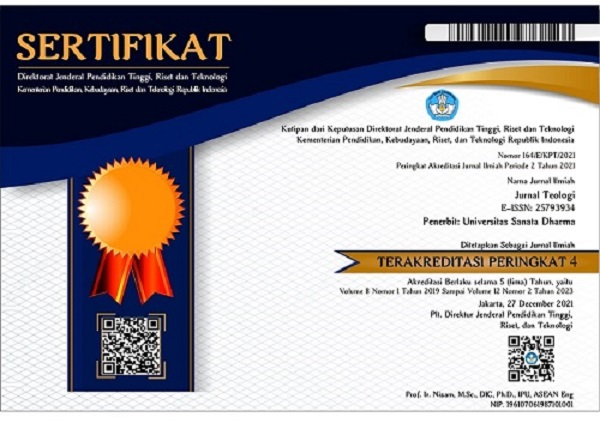'Human Dignity' dalam Pemikiran Yohanes Paulus II dan Relevansi untuk Dunia Masa Kini
(1) Sanata Dharma University
(*) Corresponding Author
Abstract
Keywords
Full Text:
PDF (Bahasa Indonesia)References
Barbour, Ian G. When Science Meets Religion. San Francisco: Harper Collins, 2000.
Buchanan, Allen. Better than Human. The Promise and Perils of Enhancing Ourselves. New York: Oxford University Press, 2011.
Coughlin, John J. “Pope John Paul II and The Dignity of Human Being”. Harvard Journal of Law and Public Policy, 65, pp. 65-79. https://scholarship.law.nd.edu/law_faculty_scholarship/494 (access 01.09.2020)
Cross, Richard. The Metaphysics of the Incarnation. Thomas Aquinas to Duns Scotus. New York: Oxford University Press, 2000.
Deep AI. “Feature Extraction”. Deep AI https://deepai.org/machine-learning-glossary-and-terms/feature-extraction (access 20.03.2021).
Dinisari, Mia Chitra. “E-commerce Dorong Perekonomian Indonesia, selama Pandemi Covid-19”. Bisnis.com. (April 2020)https://ekonomi.bisnis.com/read/20200417/12/1228750/e-commerce-dorong-perekonomian-indonesia-selama-pandemi-covid-19- (access 20.03.2021).
DW. “Algoritma Internet Bias Jender dan Seksisme”. https://www.dw.com/id/algoritma-internet-bias-gender-dan-seksisme/av-43865594 (access 20.03.2021).
Freeman, James. “What is Algoritm: Definition, Types and Application”, (Agustus 2020). https://www.edrawsoft.com/algorithm-definition.html (access 16.10.20).
Gall, Richard. “Machine Learning Ethics: What you need to know and what you can do?”, Packt (September 2019). https://hub.packtpub.com/machine-learning-ethics-what-you-need-to-know-and-what-you-can-do/. (access 21.09.2020).
Goodrich, Michael T. and Roberto Tamassia. Algorithm Design and Applications. Danvers: Wiley, 2015.
Hayasaki, Erika. “Has this scientist finally found the fountain of youth?”. MIT Technology Review (Agustus 2019). https://www.technologyreview.com/2019/08/08/65461/scientist-fountain-of-youth-epigenome/#Echobox=1574961006 (access 10.10.20).
Heelan, Patrick A. Space-Perception And The Philosophy of Science. California: University of California Press, 1983.
Heidegger, Martin. Being And Time. Translated by John Macquarrie and Edward Robinson. London: SCM Press, 1962.
Heilweil, Rebecca. “Why algorithms can be racist and sexist”. Vox (Februari 2020). https://www.vox.com/recode/2020/2/18/21121286/algorithms-bias-discrimination-facial-recognition-transparency (access 18.09.20).
Husserl, Edmund. The Crisis Of European Sciences And Transcendental Phenomenology. Evanston: Northwestern University Press, 1970.
John Paul II. Redemptor Hominis (1979). http://www.vatican.va/content/john-paul-ii/en/encyclicals/documents/hf_jp-ii_enc_04031979_redemptor-hominis.html (access 19.09.2020).
John Paul II. “Address to the 34th General Assembly of the United Nations Organization” (Oct. 2, 1979). http://www.vatican.va/content/john-paul-ii/en/speeches/1979/october/documents/hf_jp-ii_spe_19791002_general-assembly-onu.html (access 19.09.2020).
John Paul II. Salvifici Doloris (1984). http://www.vatican.va/holy_father/john_paul_ii/apost_letters/documents/hf_jpii_apl_11021984_salvifici-doloris_en.html (access 19.09.2020).
John Paul II. Dominum et Vivificantem (1986). http://www.vatican.va/content/john-paul-ii/en/encyclicals/documents/hf_jp-ii_enc_18051986_dominum-et-vivificantem.html (access 19.09.2020).
John Paul II. Mulieris Dignitatem (1988). http://www.vatican.va/holy_father/john_paul_ii/apost_letters/documents/hf_jpii_apl_15081988_mulieris-dignitatem_en.htm (access 19.09.2020).
John Paul II. Veritatis Splendor (1993). http://www.vatican.va/content/john-paul-ii/en/encyclicals/documents/hf_jp-ii_enc_06081993_veritatis-splendor.html (access 19.09.2020).
John Paul II. Evangelium Vitae (1995). http://www.vatican.va/content/john-paul-ii/en/encyclicals/documents/hf_jp-ii_enc_25031995_evangelium-vitae.html (access 19.09.2020).
John Paul II. Fides et Ratio (1998). http://www.vatican.va/content/john-paul-ii/en/encyclicals/documents/hf_jp-ii_enc_14091998_fides-et-ratio.html (access 19.09.2020).
John Paul II. “Apostolic Journey to Poland. Eucharistic Celebration Homily of His Holiness John Paul II”, June 10, 1999. http://www.vatican.va/content/john-paul-ii/en/homilies/1999/documents/hf_jp-ii_hom_19990610_siedlce.html (access 19.09.2020).
Li, J., R. Wang, J. Wang, and Y. Li “Analysis and forecasting of the oil consumption in China based on combination models optimized by artificial intelligence algorithms” Energy,144 (2018). pp. 243-264.
Marr, Bernard. “How Is AI Used In Healthcare - 5 Powerful Real-World Examples That Show The Latest Advances”, Forbes (September 2018). https://www.forbes.com/sites/bernardmarr/2018/07/27/how-is-ai-used-in-healthcare-5-powerful-real-world-examples-that-show-the-latest-advances/#6e4977915dfb. (access 08.10.20).
Obermeyer, Ziad, Brian Powers, Christine Vogeli, and Sendhil Mullainathan. “Dissecting racial bias in algorithm used to manage the health of population” Science (October 2019) https://science.sciencemag.org/content/366/6464/447.full (access 20.03.2021).
Petri, Thomas. Aquinas and the Theology of the Body. The Thomistic Foundation of John Paul II Antrophology. Washington: The Catholic University of America Press, 2016.
Rangaiah, Mallika. “4 Major Applications of Artificial Intelligence in Education Sector”, Analytic Steps (April 2020). https://www.analyticssteps.com/blogs/4-major-applications-artificial-intelligence-education-sector. (accessed 08.10.2020).
Richard, Edouard, Judith Duportail, Nicolas Kayser-Brill, Kira Schacht. “Undress or fail: Instagram’s algorithm strong-arms users into showing skin” Algorithm Watch (June 2020) https://algorithmwatch.org/en/story/instagram-algorithm-nudity/ (access 20.03.2021).
Richard, Edouard, Judith Duportail, Nicolas Kayser-Brill, Kira Schacht, “Undress or fail: Instagram’s algorithm strong-arms users into showing skin” European Data Journalism (June 2020) https://www.europeandatajournalism.eu/eng/News/Data-news/Undress-or-fail-Instagram-s-algorithm-strong-arms-users-into-showing-skin (access 20.03.2021).
Schellenberg, Susanna. “How Biased Algorithms Perpetuate Inequality?”, New Statesman (April 2020). https://www.newstatesman.com/science-tech/2020/04/how-biased-algorithms-perpetuate-inequality (access 18.09.2020).
Sharma, Gagan Deep. Anshita Yadav, Ritika Chopra. “Artificial intelligence and effective governance: A review, critique and research agenda”, Sustainable Futures 2 (2020) 100004, accessed from www.elsevier.com/locate/sftr (access 15.09.2020).
Soken-Huberty, Emmaline. “What is Human Dignity? Common Definition”, Human Rights Careers, https://www.humanrightscareers.com/issues/definitions-what-is-human-dignity/ (access 20.03.2021).
Sorondo, Marcelo Sánchez. (ed) What Is Our Real Knowledge about Human Being.Vatican: PAS, 2007.
Steinman, Rinie. “The Core Meaning of Human Dignity”. SCIELO South Africa. http://www.scielo.org.za/ scielo.php?script=sci_arttext&pid=S1727-37812016000100023 (access 15.09.2020).
The Center for Bioethics and Human Dignity. “Human Dignity”. https://cbhd.org/category/issues/human-dignity (access 20.03.2021).
Turing, Alan. “Computing Machinery and Intelligence”. Mind, 50 (1950). pp.433–460
Weigel, George. Witness To Hope: The Biography Of Pope John Paul II. New York: Harper Collins, 1999.
Wojtyla, Karol. The Acting Person. Boston: D. Reidel Pub. Co., 1979.
Wojtyla, Karol. Person and Community: Selected Essays.Translated by Theresa Sandok. New York: Lang, 1993.
Wojtyla, Karol. Love and Responsibilty. Boston: Pauline Books and Media, 2013.
DOI: https://doi.org/10.24071/jt.v10i1.2905
Refbacks
- There are currently no refbacks.

This work is licensed under a Creative Commons Attribution-ShareAlike 4.0 International License.
.jpg)
Indexed and abstracted in:
P-ISSN: 2302 - 5476 (Validity starting Volume 2012-10-05)
E-ISSN: 2579 - 3934 (Validity starting Volume 6, No. 1, Mei 2017)
Jurnal Teologi (Journal of Theology) by Faculty of Theology Sanata Dharma University

This work is licensed under a Creative Commons Attribution-ShareAlike 4.0 International License.














